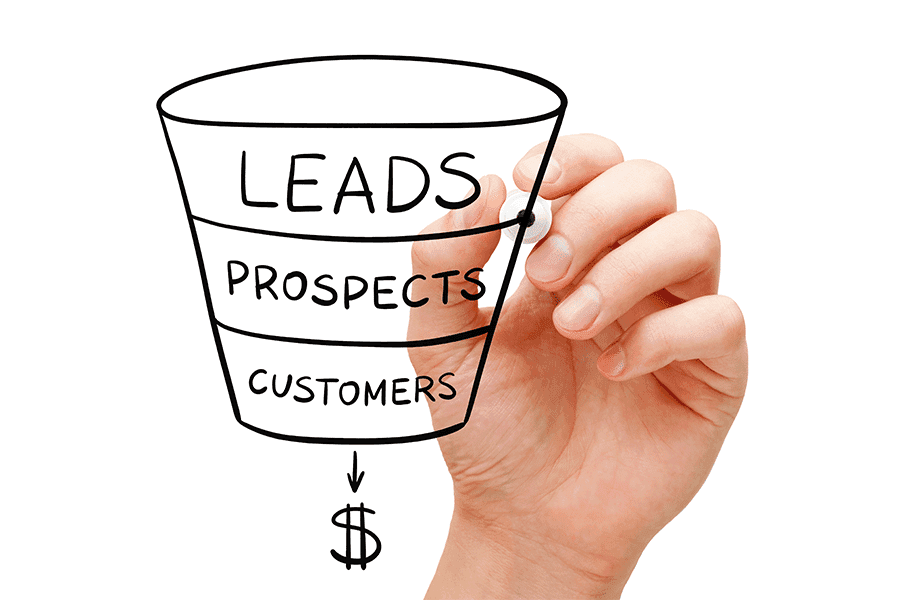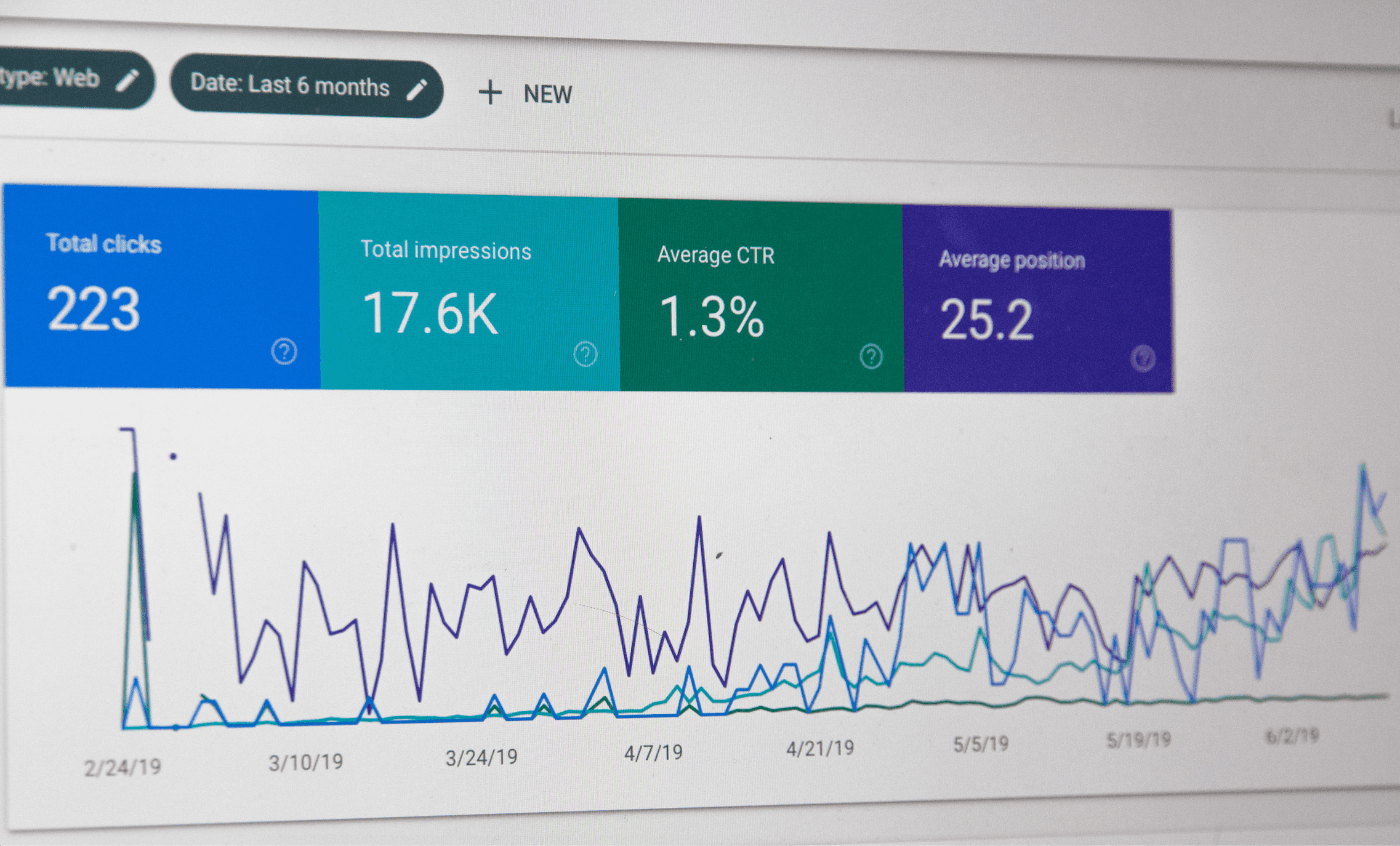SMS Marketing for E-commerce: The Complete Beginner’s Guide

SMS marketing has transformed the e-commerce landscape by enabling direct communication with customers on their mobile devices, resulting in significantly higher engagement and conversion rates.
Here are some quick SMS marketing statistics to get you started:
• Impressive Open Rates: SMS marketing boasts an astounding open rate of over 90%, far surpassing other marketing channels.
• Immediate Response: More than 90% of people open a text message within three minutes of receiving it.
• Preference for SMS: 85% of smartphone users prefer receiving promotional messages via SMS rather than emails or phone calls.
• Unanswered Customer Queries: Shockingly, one in three customers sends an SMS to a business but never receives a reply.
• Email Marketing Challenges: Traditional email marketing faces challenges, with 55% of customers ignoring marketing emails.
In the following chapters, we will delve deeper into everything SMS marketing and cover topics such as building a subscriber list, crafting compelling campaigns, complying with regulations, and measuring the impact of your SMS marketing efforts.
By the end of this guide, you will be ready to take your SMS marketing to the next level!
What to Expect:
Advantages of SMS Marketing over Other Channels
Getting Started with SMS Marketing
How to Acquire Phone Numbers for SMS Campaigns
Complying with SMS Marketing Regulations and Best Practices
How to Select the Right SMS Platform
The 5 Best SMS Tools and Platforms
Building an SMS Marketing Strategy
How to Segment Your SMS Customer Database
How to Create Compelling SMS Campaigns
Creating Engaging SMS Campaigns
The Art of Writing Persuasive SMS Messages
Timing and Frequency Considerations for Text Messaging
1. When is the best time to send an SMS?
2. How many SMS messages should you send?
How to Use Transactional Messages for Customer Engagement
Strategies to Increase Opt-Ins
Measuring Success with SMS Marketing
SMS Marketing Key Performance Indicators (KPIs)
Future Trends in SMS Marketing for E-commerce
Emerging Technologies: AI and Chatbots
Evolving Consumer Expectations
What is SMS Marketing?

SMS marketing involves sending promotional and transactional text messages directly to customers’ mobile devices. Its power lies in the immediate and personal connection it establishes with customers, cutting through the noise of other marketing channels.
Advantages of SMS Marketing over Other Channels

1. Higher Open Rates
As mentioned earlier, SMS marketing enjoys an exceptional open rate, ensuring your messages are not lost in a sea of unread emails or overlooked on social media.
2. Rapid Response Times:
With over 90% of recipients opening texts within three minutes, SMS marketing is the ultimate tool for time-sensitive promotions, flash sales, or urgent announcements.
3. Personal Touch
SMS marketing offers a more personal touch compared to email marketing. It is like a swift messenger delivering your message directly to the customer’s doorstep, while email resembles sending a letter that gets lost in a crowded mailbox.
4. Building Customer Loyalty
SMS marketing fosters a sense of exclusivity and personal connection with customers. You can nurture customer loyalty by consistently communicating with them, establishing trust, and delivering on promises.
Getting Started with SMS Marketing

How to Acquire Phone Numbers for SMS Campaigns
Phone numbers are like precious gems; you must obtain them ethically and handle them responsibly to ensure long-term value.
Methods of collecting phone numbers:
• Opt-ins Through Your Website: Implement user-friendly opt-in forms on your website, where visitors can willingly subscribe to receive SMS updates.
• In-Store: For brick-and-mortar businesses, provide options for customers to subscribe to SMS updates when they visit your store.
• Other Touchpoints: Explore other channels where you can collect phone numbers ethically, such as events, social media, or partner collaborations.
Complying with SMS Marketing Regulations and Best Practices

It is important to adhere to regulations like the Telephone Consumer Protection Act (TCPA) and industry best practices in order to avoid legal issues and maintain customer trust. Here are some key regulations you should keep in mind:
• TCPA Compliance: Familiarize yourself with the TCPA guidelines to ensure you obtain proper consent from customers before sending them any messages.
• Opt-Out Mechanism: Include a clear and easily accessible opt-out mechanism in your messages to allow recipients to unsubscribe at any time.
• Data Security: Implement robust data security measures to protect your subscribers’ phone numbers and personal information.
How to Select the Right SMS Platform

Selecting the appropriate SMS marketing platform is crucial for success. When choosing an SMS marketing platform for your e-commerce business, consider the following factors:
• Integration: Ensure the platform seamlessly integrates with your e-commerce system or customer database.
• Features: Match the platform’s features with your specific marketing needs, whether automated campaigns, personalization, or analytics.
• Pricing: Evaluate the cost structure, including monthly fees, message rates, and any additional charges.
• Compliance: Confirm that the platform complies with SMS marketing regulations and provides opt-out options for recipients.
• User-Friendliness: Assess the platform’s ease of use, as this can impact your team’s efficiency.
• Customer Support: Look for platforms that offer reliable customer support, including technical assistance and training resources.
By carefully considering these factors and exploring the features of different SMS marketing platforms, you can make an informed decision that aligns with your e-commerce business’s goals and objectives.
The 5 Best SMS Tools and Platforms

1. Twilio
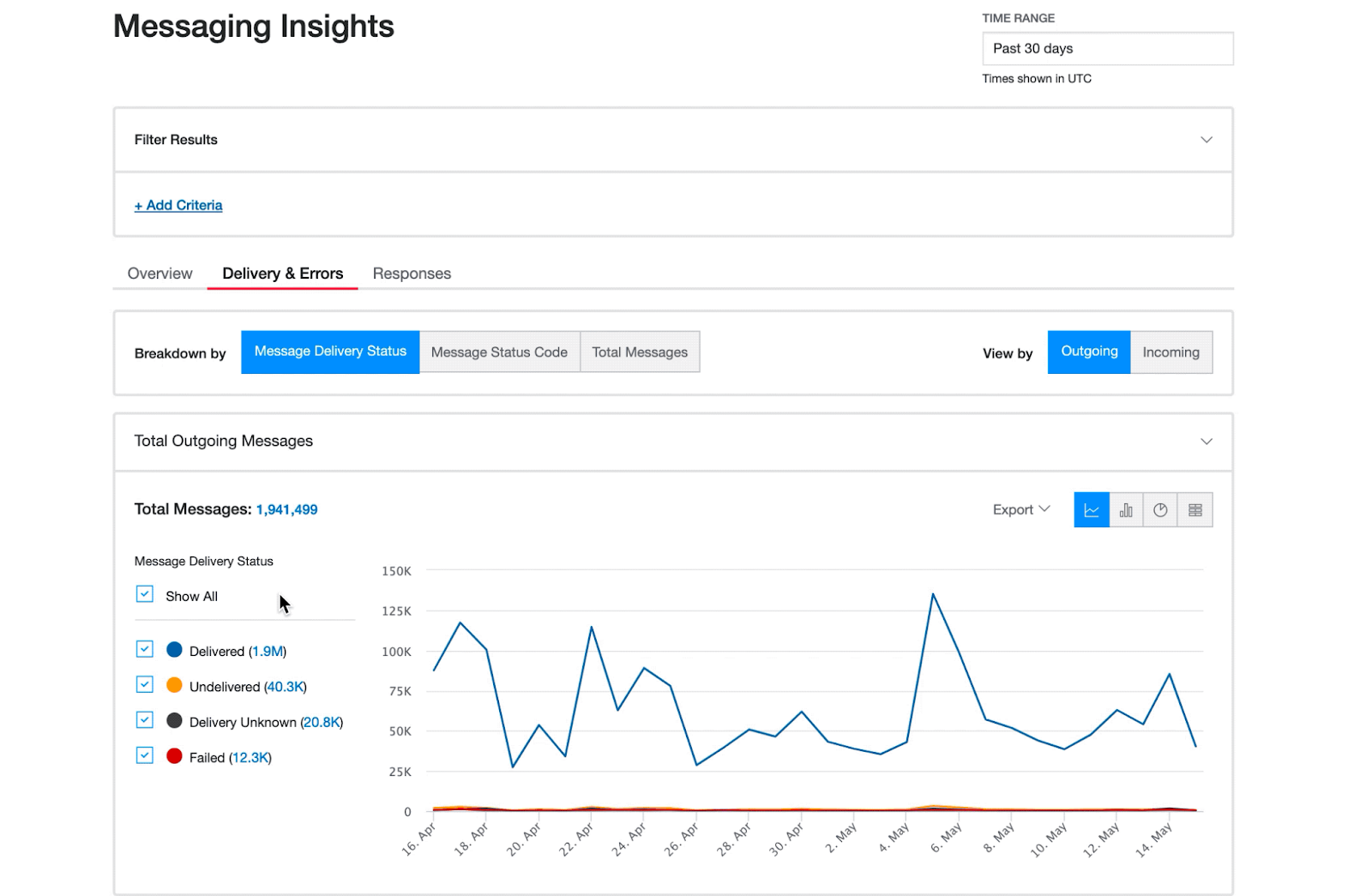
Twilio is a versatile cloud communications platform that offers SMS capabilities, allowing you to send and receive text messages at scale. It provides robust APIs for customization, real-time tracking, and analytics to measure campaign effectiveness.
Consider Twilio If: You will be using SMS as part of a broader communication strategy and need a highly customizable solution with extensive developer resources.
2. SMSBump
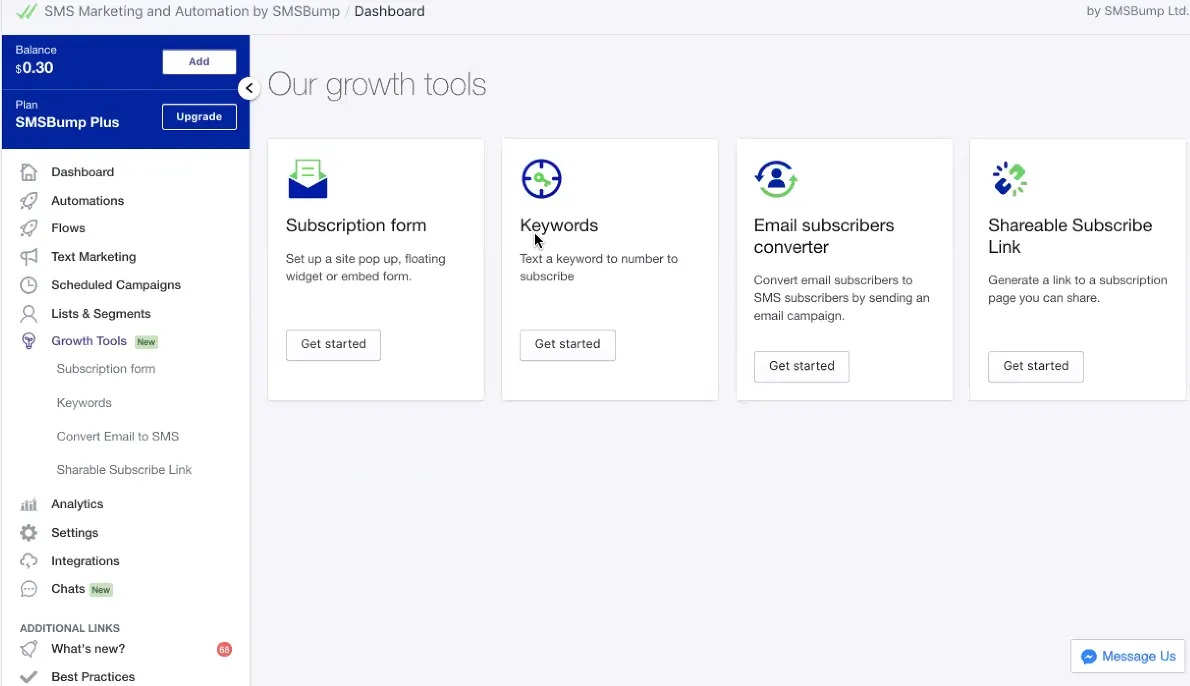
SMSBump is a user-friendly SMS marketing platform designed specifically for e-commerce businesses. It integrates seamlessly with popular e-commerce platforms like Shopify and WooCommerce, offering features like automated SMS campaigns, cart recovery, and personalized messaging.
Consider SMSBump If: You already have an e-commerce store and want an easy-to-use platform that integrates seamlessly with your existing e-commerce setup.
3. Omnisend
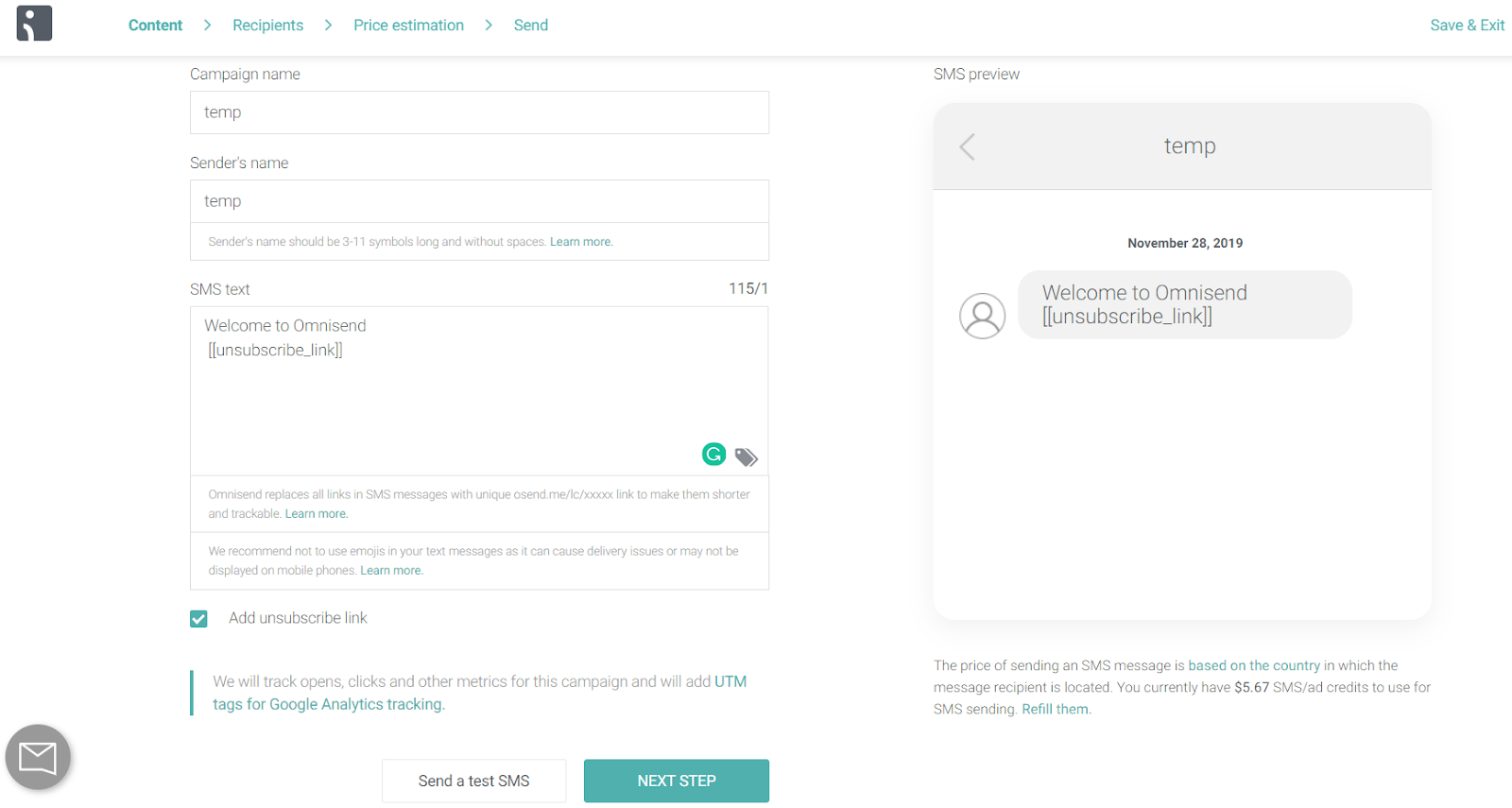
Omnisend is an omnichannel marketing automation platform that includes SMS marketing as one of its communication channels. It allows you to create automated workflows, segment your audience, and send targeted SMS campaigns along with emails and push notifications.
Consider Omnisend If: You want a unified marketing platform that enables you to combine SMS marketing with other channels like email and push notifications for a cohesive customer experience.
4. Textedly
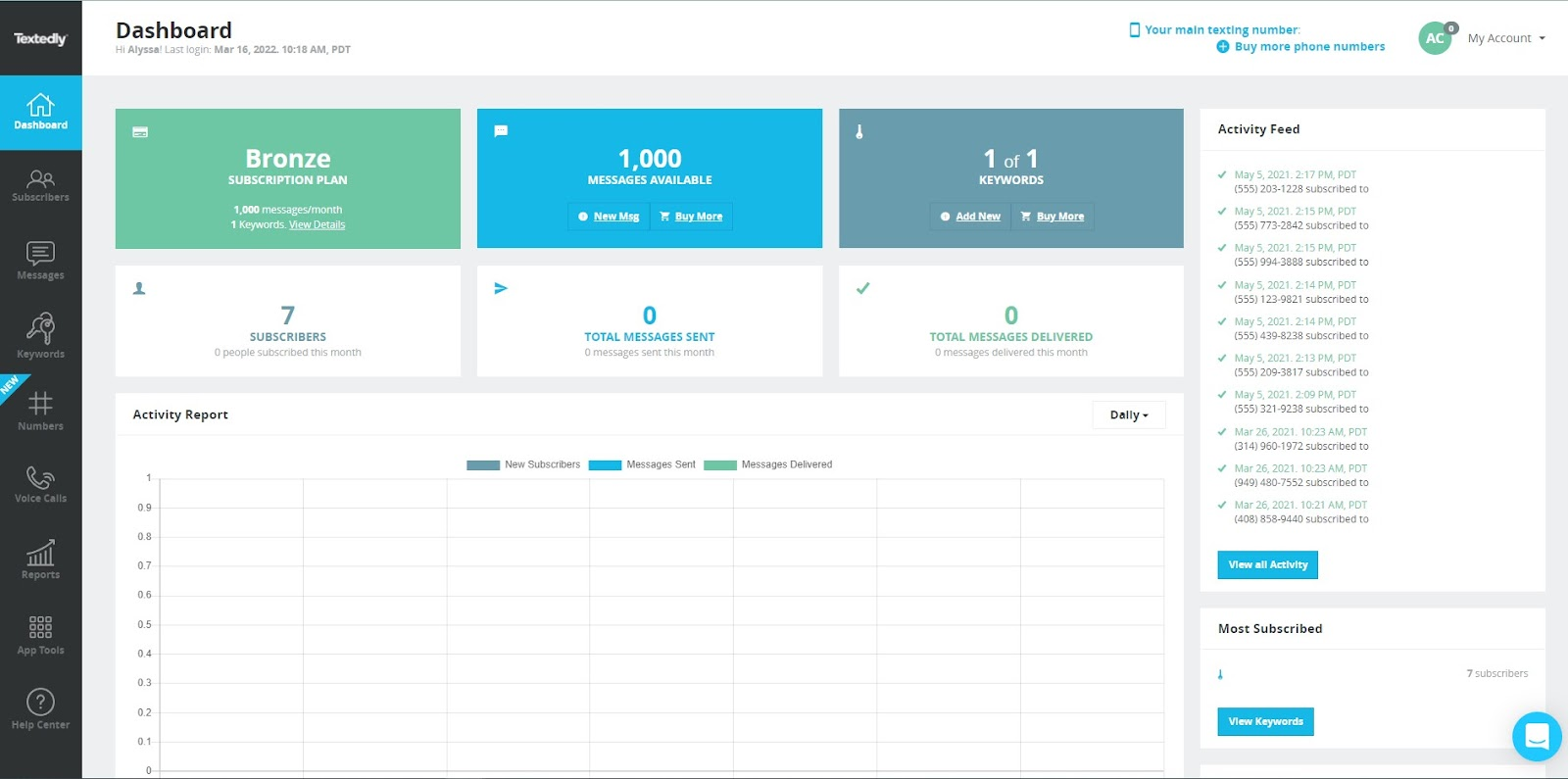
Textedly is a straightforward SMS marketing platform suitable for small to medium-sized businesses. It offers features like contact management, drip campaigns, and scheduling, making it easy for businesses to get started with SMS marketing.
Consider Textedly If: You’re a small business owner looking for an affordable, user-friendly SMS marketing platform with basic features.
5. ActiveCampaign
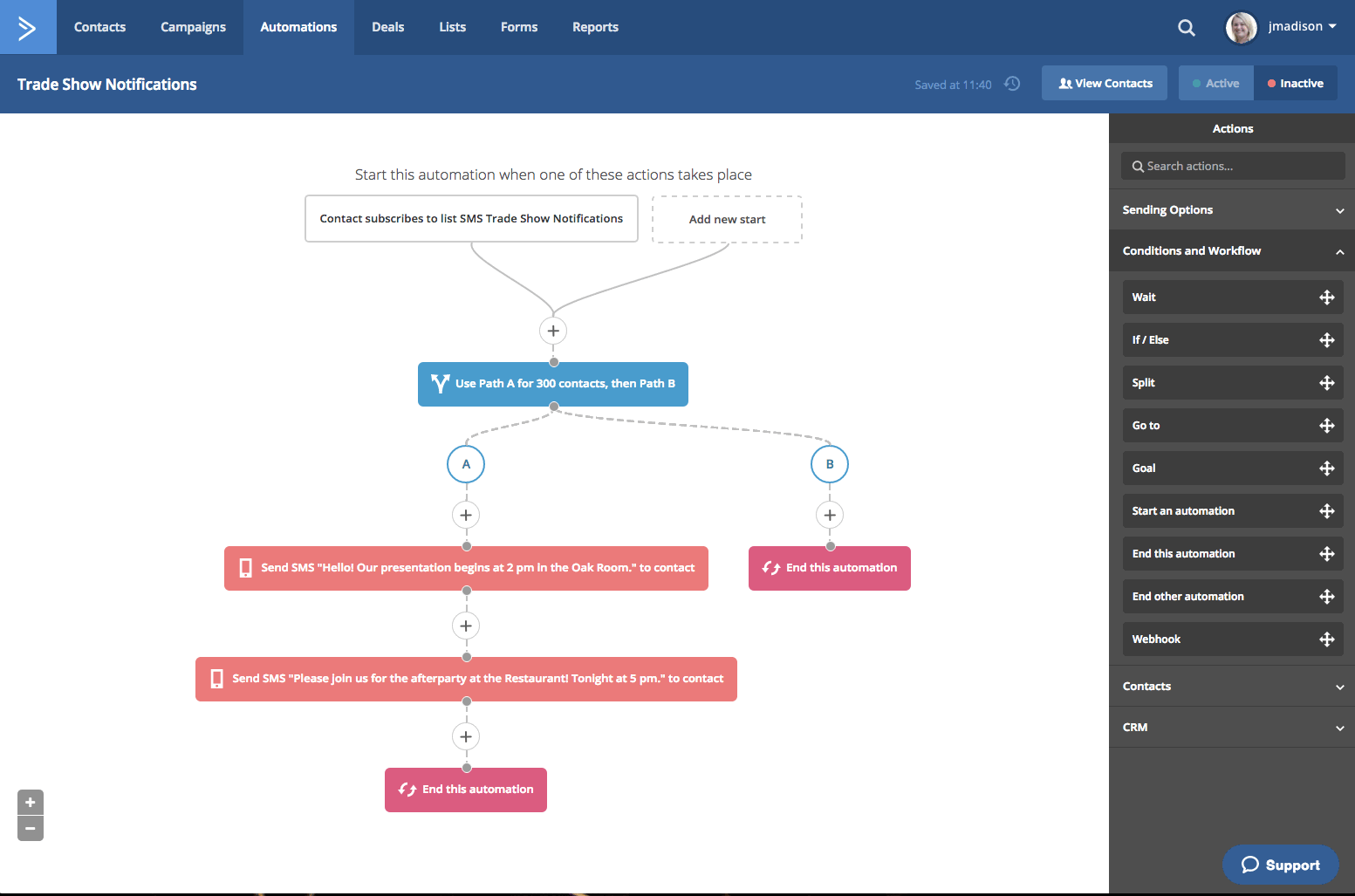
ActiveCampaign is a comprehensive marketing automation platform that offers SMS marketing as a communication channel. It also offers advanced automation capabilities, CRM integration, and powerful segmentation.
Consider ActiveCampaign If: You need a sophisticated marketing automation platform that combines SMS marketing with email marketing and CRM capabilities for a highly personalized customer journey.
Building an SMS Marketing Strategy

How to Segment Your SMS Customer Database

Segmenting your customer base involves dividing your audience into distinct groups based on common characteristics such as demographics, behavior, and preferences. This will enable you to send highly relevant and personalized messages.
a. The Power of Segmentation:
Just as a tailor crafts a suit to fit an individual’s unique body shape, segmentation allows you to tailor your messages to fit each customer’s unique interests and needs. For instance, if you sell clothes, it can help you create segments based on gender. This way, you can target women customers with women-specific promotions and male customers with men-specific promotions.
b. Strategies for Segmentation:
There are so many different strategies you can use to segment your audience, including demographics, purchase history, location, and engagement level. However, don’t just stop at these broad categories, dial in your segments to smaller niches based on data.
Once you’ve created enough customer segments, use data analytics tools to derive insights and create messages tailored to their interests.
How to Create Compelling SMS Campaigns

Crafting a compelling campaign is an art. It involves delivering a clear, concise message that captures attention, invokes curiosity, and encourages action. Let’s take a look.
Key Elements of SMS Campaigns:
1. Persuasive Language: Persuasive language in SMS campaigns involves crafting messages that captivate recipients’ attention, evoke emotions, and compel them to take action. Example:
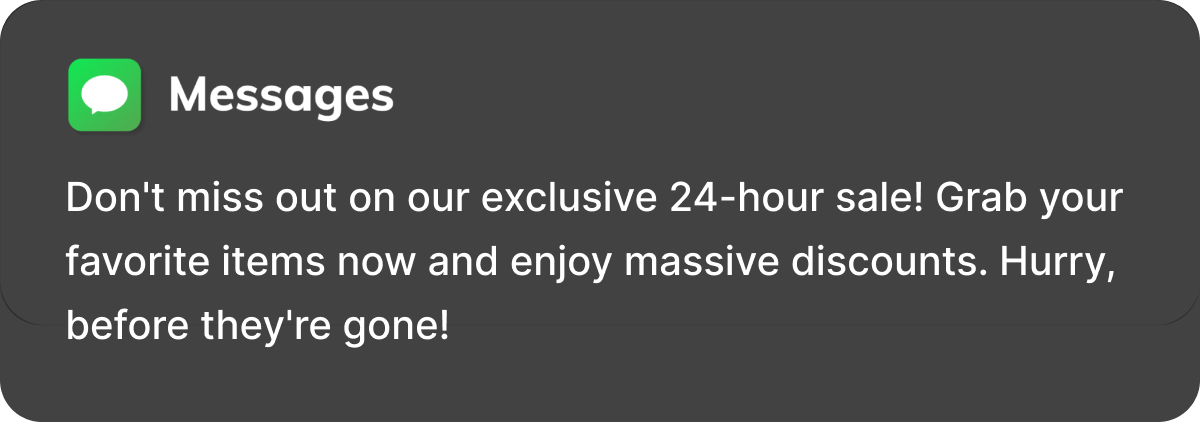
2. Strong Call-to-Action (CTA): A compelling CTA is essential for guiding recipients on what action to take next. It should be clear, action-oriented, and convey a sense of benefit. Example:

3. Sense of Urgency: Creating a sense of urgency instills a fear of missing out (FOMO) in recipients, prompting them to act quickly. Example:

4. Personalization: Personalized SMS messages make recipients feel valued and understood. Address them by name and tailor the message to their preferences and past interactions. Example:

5. Clear and Concise Messaging: SMS messages have character limitations, so conveying your message succinctly and avoiding unnecessary details is crucial. Example:

6. Offer Value or Benefit: Clearly communicate the value or benefit that recipients will gain from taking the desired action. Example:

7. Relevant Timing: Send messages when they are most likely to be seen and acted upon. Consider recipients’ time zones and daily routines. Example:

8. Unsubscribe Option: Include an option for recipients to easily opt out of future SMS messages to maintain compliance with SMS marketing regulations. Example:

9. Tracking and Analytics: Implement tracking links or unique promo codes to measure the success of your SMS campaign and gather insights for future improvements. Example:

To create effective SMS campaigns, leverage all of these elements to engage recipients, drive actions, and deliver results. However, you don’t have to use all the elements together. You can mix and match them as you desire to create the perfect message.
Creating Engaging SMS Campaigns

The Art of Writing Persuasive SMS Messages

Don’t just create text messages, create stories or use storytelling elements to elevate your messages. Narratives have the power to captivate an audience, trigger different emotions, and create connections.
Storytelling Elements You Can Use:
Effective storytelling in SMS marketing is all about condensing a compelling narrative into a limited character count while still engaging emotions and creating a connection with the recipient. Here are the key storytelling elements to consider:
• Relatable Protagonist (the customer): The protagonist in your SMS marketing story should be the customer. Make them the hero of the story by addressing their needs, desires, and pain points. Use language and scenarios that resonate with their experiences to establish a connection.
• Problem to Solve: Every good story has a conflict or problem that needs resolution. This could be the customer’s pain points, challenges, or unmet needs. Clearly define the problem you’re addressing to capture their attention and evoke empathy.
• Solution (your product or service): Your product or service is the hero’s tool or weapon in overcoming the problem. Highlight how it can solve the customer’s pain points and make their life better. Be concise in explaining why your solution is unique and effective.
• Emotion and Connection: Use strong language that stirs emotions and connects with the recipient on a personal level. Create a sense of urgency or desire to take action. Emphasize the benefits and how they will positively impact the customer’s life.
• Engagement through a Call to Action: A compelling story should lead to action. Include a clear and concise call to action (CTA) that tells the recipient what you want them to do next. This could be a link to your website, a coupon code, or an invitation to visit your store.
• Consistency and Frequency: Consistency in your storytelling helps build brand identity. Whether it’s a weekly SMS update or a series of messages, maintain a consistent narrative style and tone. Frequent but not overwhelming communication will help keep your story alive and top-of-mind for your audience.
• Feedback and Iteration: Pay attention to customer feedback and adjust your storytelling strategy accordingly. This iterative process ensures that your narrative remains relevant and continues to resonate with your audience over time.
Amazing SMS Marketing Examples and Templates

Timing and Frequency Considerations for Text Messaging

Timing is crucial in SMS marketing. Just as a chef times each ingredient in a recipe to perfection, sending SMS messages at the right time can significantly impact their effectiveness.
1. When is the best time to send an SMS?
• Target Audience’s Time Zone: Send SMS messages at a time when your target audience is most likely to be awake and active. Consider the time zone of your recipients, especially if you have a geographically diverse customer base.
• Daily Routines: Understand your audience’s daily routines to determine the best times to send messages. For example, if you are promoting a lunch special at a restaurant, consider sending an SMS around mid-morning when people are thinking about lunch plans.
• Industry-Specific Considerations: Different industries have varying optimal times for sending SMS messages. For example, retailers might find that sending promotional SMS messages on weekends or during lunch breaks works well, while B2B companies may have better success during weekdays when professionals are at work.
• A/B Testing: It’s essential to A/B test different sending times to identify the specific times that yield the best results for your audience. Conduct experiments to determine when your messages are more likely to be opened and acted upon.
• Holidays and Special Occasions: Consider holidays and special occasions which are relevant to your audience. However, be respectful of cultural sensitivities and ensure your messages align with the occasion.
2. How many SMS messages should you send?
• Preference Settings: Give subscribers control over the frequency of messages they receive. Allow them to opt in or out of specific message types or choose how often they receive messages. Respecting their preferences can reduce message fatigue.
• Content Relevance: Ensure that every message you send is relevant and valuable to the recipient. Avoid sending repetitive or irrelevant messages that can lead to fatigue. Personalization can help make messages more appealing.
• Automated Drip Campaigns: Use automated drip campaigns to send a series of messages over time, spreading out the content and reducing the risk of overwhelming subscribers with too many messages at once.
• Monitoring Engagement: Keep a close eye on engagement metrics like open rates and click-through rates. If you notice a decline in engagement, consider adjusting your message frequency or content strategy.
• Feedback and Surveys: Encourage subscribers to provide feedback on the frequency of your messages. Conduct surveys to understand their preferences better and make adjustments accordingly.
• Seasonal Adjustments: Be mindful of seasonal fluctuations in customer behavior. During peak shopping seasons, you may increase message frequency, but during slower periods, reduce it to avoid annoyance.
How to Use Transactional Messages for Customer Engagement

Transactional messages, such as order confirmations and shipping updates, are typically seen as straightforward, operational communications in the customer journey. However, they represent an often untapped resource for enhancing customer engagement and driving business growth. Here are strategies you can use to turn transactional messages into valuable engagement opportunities:
1. Upselling and Cross-Selling:
Transactional messages offer a unique moment of customer attention. By including product recommendations or exclusive discounts within these messages, businesses can encourage customers to make additional purchases beyond their initial transaction. For instance, if a customer has just bought a smartphone, a transactional message can suggest complementary accessories like phone cases or headphones, thereby increasing the average order value and maximizing revenue.
2. Feedback and Reviews:
A transaction confirmation or delivery update isn’t just about informing customers of their order status; it’s also an opportunity to solicit feedback or encourage them to leave reviews. By integrating feedback forms or review requests into these messages, you can gather valuable insights, improve their products or services, and build trust with customers.
Growing Your SMS Subscribers

Strategies to Increase Opt-Ins
SMS marketing is all about the numbers. The more subscribers you have, the higher your revenue. Here are proven strategies you can use to increase your SMS sign-ups.
1. Value Proposition
Value proposition refers to the distinguishable elements that make your product or service attractive to your ideal customers. Here are 3 things you can include in your text messages to build value:
a. Highlight Benefits: Clearly communicate the advantages of opting in, such as receiving exclusive offers, staying updated with relevant information, and gaining access to valuable content.
b. Personalization: Emphasize that subscribers will receive messages tailored to their interests, making the content more relevant and engaging for them.
c. Exclusivity: Convey the sense of exclusivity that comes with being an SMS subscriber, such as getting early access to sales or products not available to non-subscribers.
2. Trust
Trust is a core element of any successful transaction. In SMS, you can build trust by:
a. Embracing Transparency: Be transparent about how subscriber information will be used. Assure them that their data will be protected and won’t be shared with third parties.
b. Enhancing Data Security: Highlight your compliance with data privacy regulations like GDPR or CCPA. Let subscribers know that you take their privacy seriously.
3. Incentives
Incentives are a critical part of your SMS marketing strategy. They provide subscribers with compelling reasons to opt in and engage with your brand through text messages.
a. Discounts: Offer subscribers discounts on future purchases as a reward for opting in. This provides an immediate and tangible benefit, saving them money on products or services they are interested in.
b. Exclusive Offers: Provide access to exclusive sales, events, or products that are only available to SMS subscribers. This creates a sense of belonging and privilege, making subscribers feel like valued insiders.
c. Early Access: Give subscribers a sneak peek at new products or promotions before they are made available to the general public, making them feel like insiders. This sense of exclusivity can be a powerful motivator.
4. Compliance and Transparency
Building trust with your subscribers is essential. Transparency and compliance with data privacy regulations are key elements of this trust-building process.
a. Clear Communication: Clearly explain what subscribers can expect in terms of message frequency and content. Set their expectations from the beginning to avoid surprises and ensure a positive user experience.
b. Data Usage: Describe how user data will be used, stored, and protected. Ensure that your practices align with data privacy regulations and communicate this to subscribers. This reassures them that their personal information is safe in your hands.
5. Website Integration
Making it easy for visitors to opt in on your website is crucial. It should be a seamless process that adds value for the user.
a. Opt-In Forms: Place opt-in forms strategically on high-traffic pages of your website, such as the homepage or product pages. This makes it convenient for visitors to subscribe without having to search for the option.
b. Simplified Process: Make the opt-in process as quick and easy as possible. Request only essential information, such as their phone number, to minimize friction. Users appreciate a hassle-free experience.
6. Engagement Prompts
Engagement prompts are your opportunity to capture the attention of website visitors and convert them into subscribers.
a. Exit-Intent Pop-Ups: Use pop-ups that appear when visitors are about to leave your site. Offer an enticing incentive, like a discount, to encourage them to subscribe before they go. This gives them a reason to stay engaged with your brand.
b. Timed Pop-Ups: Trigger pop-ups after a certain amount of time spent on your site, gently nudging visitors to opt in as they explore your content. Timing is crucial in capturing their interest.
c. Content Offers: Provide valuable content, such as ebooks or guides, in exchange for a subscription. This adds immediate value for the visitor, making the subscription worthwhile.
7. Data Security
In this day and age, users are already wary and suspicious about how their data is handled. Assuring subscribers of the security of their data is a fundamental way to build trust.
a. Privacy Assurance: Reiterate on your website that subscriber data is safe and won’t be shared with third parties. Building trust is crucial in gaining opt-ins. Highlight your commitment to protecting their privacy.
b. Compliance: Mention your compliance with data protection regulations prominently to assure visitors of your commitment to their privacy. This demonstrates that you take data security seriously.
8. Retaining and Re-Engaging SMS Subscribers Over Time
Keeping subscribers engaged is about delivering ongoing value.
a. Engagement Strategies: Keep subscribers engaged by sending them regular, relevant, and valuable content updates. Show them that being a subscriber is worthwhile by providing information or offers they find useful.
b. Exclusive Offers: Reward loyal subscribers with exclusive discounts or promotions. Make them feel appreciated for their continued support and loyalty to your brand.
c. Interactive Campaigns: Create interactive polls, surveys, or quizzes to involve subscribers and make the SMS channel more engaging and participatory. This enhances their overall experience.
9. Win-Back Campaigns
Win-back campaigns are an opportunity to rekindle the relationship with dormant subscribers.
a. Targeted Messaging: Craft personalized messages aimed at re-engaging dormant subscribers. Use their past interactions and preferences to tailor your approach. Remind them of what they’ve missed.
b. Incentives: Offer incentives, such as limited-time offers or special discounts, to entice dormant subscribers to return and re-engage with your brand. Provide them with a compelling reason to come back.
10. Feedback Loops
Feedback loops are a way to show subscribers that you value their input and are committed to improving their experience.
a. Request Feedback: Encourage subscribers to provide feedback on their preferences, interests, and overall SMS experience. Make it easy for them to share their thoughts and opinions, showing that you value their input.
b. Continuous Improvement: Use the feedback you receive to refine your SMS campaigns and enhance the customer experience. Show that you value their input and are committed to improving their experience. This reinforces your dedication to meeting their needs.
Measuring Success with SMS Marketing

SMS Marketing Key Performance Indicators (KPIs)

1. Open Rates
Open rates provide a basic metric of engagement, but to truly measure the impact of your SMS campaigns, you must delve into KPIs like click-through rates, conversion rates, and return on investment (ROI). Open rates are like the tip of the iceberg; the real insights lie beneath the surface.
2. Click-Through Rates (CTR)
Click-through rate (CTR) is a metric that measures the percentage of recipients who click on a link or take a specific action in response to an SMS message.
In SMS marketing, CTR indicates how effective your message is at prompting recipients to take the desired action, such as visiting your website, making a purchase, or engaging with your content.
It’s calculated by dividing the number of clicks by the number of delivered messages and multiplying by 100 to get a percentage. The higher the CTR, the better, and vice versa.
3. Conversion Rates
Conversion rate measures the percentage of recipients who complete a desired action or goal, such as making a purchase, signing up for a newsletter, or filling out a contact form after receiving an SMS.
Conversion rates in SMS marketing reveal the effectiveness of your campaign in driving meaningful actions. To calculate it, divide the number of conversions by the number of delivered messages and multiply by 100 to get a percentage. A high conversion rate indicates that your SMS campaign successfully motivates recipients to take the intended action.
4. Return on Investment (ROI):
Return on investment (ROI) measures the profitability of an SMS marketing campaign by comparing the gain or benefit (e.g., revenue generated) to the cost of the campaign.
ROI is a crucial metric to assess the financial performance of your SMS marketing efforts. To calculate ROI, subtract the total cost of the SMS campaign from the revenue generated as a result of the campaign. Then, divide the result by the total cost and multiply by 100 to get a percentage.
A positive ROI indicates that your SMS campaign was profitable, while a negative ROI calls for optimization. ROI helps you allocate resources effectively and make informed decisions about your SMS marketing strategy.
5. A/B Testing and Optimization
A/B testing allows you to discover what resonates best with your audience and refine your approach accordingly. You can notice substantial improvement in performance by tweaking details like the wording of a call to action or by adjusting the time you send a message.
Future Trends in SMS Marketing for E-commerce

Emerging Technologies: AI and Chatbots

Artificial intelligence (AI) and chatbots are revolutionizing SMS marketing by adding a layer of intelligence and automation to customer interactions. AI-driven chatbots can engage with customers in real time, understand their preferences, and provide personalized responses.
These technologies offer efficiency and personalization at scale, allowing e-commerce businesses to engage with customers 24/7 and deliver relevant content and product recommendations.
Evolving Consumer Expectations

Consumers now expect SMS interactions to be fast and highly personalized. They anticipate receiving messages that are relevant and timely
Meeting these expectations is crucial for customer satisfaction and retention. Businesses that provide real-time responses and tailored offers via SMS are more likely to capture and retain attention.
Conclusion

In conclusion, SMS marketing is a powerful tool that can offer you direct and engaging communication with customers. Take advantage of the impressive open rates, immediate response times, and preference among smartphone users to grow your business.
In case you are looking for a digital marketing agency to help you navigate SMS marketing, reach out to us. At SeedX, we understand the evolving dynamics of ecommerce marketing and are well-equipped to help you integrate SMS into your marketing strategy. Contact us today to embark on a journey toward increased engagement, higher conversion rates, and lasting customer loyalty.






